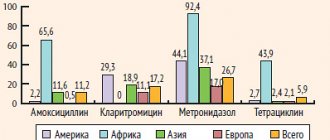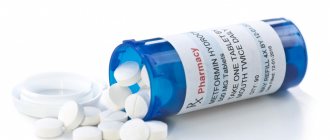Pharmacodynamics and pharmacokinetics
Pharmacodynamics
The Pharmacopoeia indicates that this drug improves the metabolism of cells of the nervous system. The structural formula of glutamic acid is C5H9NO4. A non-essential amino acid, present in the body only in the levorotatory form ( L glutamic acid a ). Acts as a mediator with pronounced metabolic activity in brain tissue, activates redox reactions in the brain, as well as protein metabolism. Regulates metabolism, transforming the functional status of the endocrine and nervous systems. Stimulates the transfer of excitation in neuronal synapses, promotes the neutralization and evacuation of ammonia , and increases resistance to hypoxia.
An important component of myofibrils , a component of the synthesis of other amino acids, ATP, acetylcholine, urea , helps transport and maintain the required content of potassium in brain tissue, serves as an intermediary between the metabolism of nucleic acids and carbohydrates, and normalizes the level of glycolysis in tissues. Has a hepatoprotective effect, suppresses the secretory function of stomach cells.
Pharmacokinetics
Has a high degree of absorption. It overcomes histohematic barriers, membranes of subcellular structures and cell membranes well. Accumulates in the liver, kidneys and soft tissues. Excreted in urine (5-7%) in its original form.
The role of glutamic acid in the body
Glutamic acid is responsible for activating metabolic processes occurring in the brain. It acts as a mediator of nerve impulses, increasing their activity. A sufficient amount of amino acid ensures stimulation of recovery processes in the brain, while simultaneously promoting protein metabolism.
Thanks to ongoing metabolic processes, the functions of the nervous system change and the functioning of the endocrine system is restored. At the same time, glutamic acid helps ensure the neutralization of ammonia and its removal from the body. The absence of glutamic acid deficiency increases resistance to hypoxia.
A person receives glutamic acid from the outside through food. In addition, it is synthesized by the body itself as a result of protein catabolism processes. The substance easily penetrates the blood-brain barrier, which prevents the passage of most drugs from the arterial bed to the brain tissue. The cell membrane is also not an insurmountable barrier to glutamic acid. It undergoes metabolic processes, and up to 7% of the incoming volume is excreted from the body by the kidneys. For progressive myopathy, an effective combination with glycine or pachycarpine has been identified.
Indications for use
Indications for the use of Glutamic acid (in complex therapy):
- inhibition of mental development of various etiologies, cerebral palsy , consequences after birth intracranial trauma, poliomyelitis , Down's disease ;
- schizophrenia, epilepsy (minor seizures), psychosis , depressive reactive state, insomnia , mental exhaustion , consequences of encephalitis and meningitis , progressive myopathy , depression ;
- neuropathy of toxic origin due to the use of isonicotinic acid derivatives.
Glutamic acid, instructions for use (Method and dosage)
The medicine is taken orally half an hour before meals; if symptoms of dyspepsia it is used after or during meals.
Adult patients are prescribed 1 gram of the drug up to three times a day.
- Children under 1 year of age are prescribed 100 mg per day.
- Up to 2 years of age, 150 mg per day is prescribed.
- Children 3-4 years old are prescribed 250 mg per day.
- Children 5-6 years old are prescribed 400 mg per day.
- Children 7-9 years old are prescribed 500-1000 mg per day.
- Children over 10 years of age are prescribed 1000 mg up to three times a day.
For oligophrenia, the drug is prescribed at the rate of 100-200 mg per kilogram of weight.
The duration of treatment is usually from 1-2 months to 1 year.
Buy Glutamic acid film-coated tablets 250 mg No. 10 in pharmacies
Glutamic acid Buy Glutamic acid in pharmacies DOSAGE FORMS enteric-coated tablets 250mg film-coated tablets 250mg
MANUFACTURERS ICN October (Russia) Tatkhimpharmpreparaty (Russia)
GROUP Amino acids
COMPOSITION Active ingredient: Glutamic acid.
INTERNATIONAL NON-PROPENTED NAME Glutamic acid
SYNONYMS L-Glutamic acid, Glutamic acid, L-Glutamic acid
PHARMACOLOGICAL ACTION Neurotransmitter, stimulating metabolism in the central nervous system. Participates in protein and carbohydrate metabolism, stimulates oxidative processes, prevents a decrease in redox potential, and increases the body's resistance to hypoxia. Normalizes metabolism, changing the functional state of the nervous and endocrine systems. It is a neurotransmitter amino acid that stimulates the transmission of excitation in the synapses of the central nervous system. Participates in the synthesis of other amino acids, acetylcholine, ATP, promotes the transfer of potassium ions, improves the activity of skeletal muscles (it is one of the components of myofibrils). It has a detoxification effect, promotes the neutralization and removal of ammonia from the body. Normalizes glycolysis processes in tissues, has a hepatoprotective effect, and inhibits the secretory function of the stomach. When taken orally, it is well absorbed and penetrates the BBB and cell membranes.
INDICATIONS FOR USE Epilepsy (mainly minor seizures with equivalents), schizophrenia, psychoses (somatogenic, intoxication, involutional), reactive states occurring with symptoms of exhaustion, depression, consequences of meningitis and encephalitis, toxic neuropathy due to the use of isonicotinic acid hydrazides (in combination with thiamine and pyridoxine), hepatic coma. In pediatrics - mental retardation, cerebral palsy, consequences of intracranial birth injury, Down's disease, poliomyelitis (acute and recovery periods).
CONTRAINDICATIONS Hypersensitivity, fever, liver and/or kidney failure, nephrotic syndrome, peptic ulcer of the stomach and duodenum, diseases of the hematopoietic organs, anemia, leukopenia, increased excitability, violent mental reactions, obesity. Restrictions on use. Kidney and liver diseases.
SIDE EFFECTS Increased excitability, insomnia, abdominal pain, nausea, vomiting, diarrhea, allergic reactions, chills, short-term hyperthermia; with long-term use - anemia, leukopenia, irritation of the oral mucosa, cracks in the lips.
INTERACTION The effectiveness of use in combination with pachycarpine or glycine has been shown for progressive myopathy.
METHOD OF APPLICATION AND DOSAGE Orally, 15-30 minutes before meals. Adults and children 10 years and older - 1 g 2-3 times a day. Children: up to 1 year - 0.1 g, 1-3 years - 0.15 g, 3-4 years - 0.25 g, 5-6 years - 0.4 g, 7-9 years - 0.5-1 g, 2-3 times a day; for oligophrenia - 0.1-0.2 g/kg. The course of treatment is from 1-2 to 6-12 months.
OVERDOSE No data available.
SPECIAL INSTRUCTIONS During the treatment period, regular general clinical blood and urine tests are necessary. If side effects occur, stop taking and consult a doctor. After oral administration in powder or suspension form, it is recommended to rinse the mouth with a weak solution of sodium bicarbonate. If symptoms of dyspepsia develop, take during or after meals.
STORAGE CONDITIONS: Store in a cool, dry place.
Analogs
Level 4 ATX code matches:
Bravinton
Acefen
Carnicetine
Pyracesin
Nooclerin
Semax
Piracetam
Olatropil
Fezam
Vinpocetine
Cerebrocurin
Cavinton Forte
Calcium hopantenate
Cephabol
Olanzapine
Cerebrolysate
Pramistar
Sidnocarb
Vinpotropil
Glycine Ozone
Antifront, Armadin, Glycine, Instenon, Intellan, Cortexin, Neurotropin, Rilutek, Cytoflavin.
Reviews about Glutamic acid
Reviews of Glutamic acid show that the drug is used only in combination with more potent drugs and is more similar in action to dietary supplements. The evidence base for the benefits of the drug for this or that pathology is weak. Glutamic acid is used separately in sports and bodybuilding.
Glutamic acid in bodybuilding and sports
The drug is often included in the diet of athletes to increase performance. It helps to recover faster after intense physical exertion, as it reduces intoxication metabolic products and has a weak anabolic effect.
Why take glutamic acid?
A quarter of the total amount of amino acids in the human body is glutamic acid. It is needed regularly in large quantities, so the body knows how to synthesize it on its own, so as not to depend on the possibility of getting it from food. Why then do you need to take it additionally?
- Most glutamic acid is concentrated in the heart muscle, blood and brain. The brain and myocardium have the highest oxygen demand, and the metabolic rate is maximum here. Glutamic acid is a substrate for cellular respiration and activates the mitochondrial respiratory chain. Therefore, it is constantly needed for the production of energy in the cell, in especially large quantities - in neurons and cardiac muscle cells. In the brain, glutamate binds and removes toxins. Other biologically active substances are synthesized from glutamic acid, which ensure vital functions; it participates in protein, carbohydrate and fat metabolism.
- The need for glutamic acid can be met through synthesis within the body, as well as with food. Its amount in products of plant and animal origin that contain protein is quite high. Therefore, a healthy person should not have an absolute deficiency of glutamic acid. But there are situations when our need for energy and amino acids increases several times, and then normal nutrition and synthesis are not enough.
- The brain contains tens of times more glutamic acid than other organs, and to ensure mental activity its concentration in the cells must be constantly maintained. Moreover, the need for it can increase under psychological stress; in this case, glutamate is used as a mediator of protective inhibition.
- Increased physical activity requires a lot of amino acids, so athletes often use sports supplements with amino acids. Glutamic acid is an important building material and source of energy for muscles. If it is not absorbed from food and is not synthesized in sufficient quantities, then physical activity can lead to loss of muscle mass.
- When losing weight, glutamic acid helps to more efficiently use stored carbohydrates and fat to obtain energy. It stimulates your metabolism and speeds up the loss of pounds by helping you burn fat without wasting muscle protein. When you diet, your metabolic rate may change as your body experiences stress. Therefore, at this time it is recommended to take additional micronutrient supplements, including glutamic acid.
- During pregnancy, the need for easily accessible amino acids increases, especially if there are signs of toxicosis. Glutamic acid improves the supply of nutrients to the fetus, prevents hypoxia, binds toxins and facilitates the general condition of the pregnant woman. It is prescribed in courses when planning pregnancy, to prevent complications in the mother, and to improve the development of the child.
- Chronic diseases, infections, and the need to adapt to a new environment also create an increased need for glutamic acid. But in difficult conditions, your own synthesis may suffer, as well as the absorption of amino acids. The glutamic acid drug will help speed up recovery and improve adaptation, since the tablet will contain molecules ready for use in the cell.
Glutamic acid price, where to buy
Buying 10 tablets of the drug in Russia will cost approximately 28 rubles.
The price of Glutamic acid in a pharmacy in Ukraine (the same release form) is 5-6 hryvnia.
- Online pharmacies in RussiaRussia
- Online pharmacies in UkraineUkraine
Pharmacy Dialogue
- Glutamic acid Vitamir (table 500 mg No. 30) Square C
99 rub. order
show more
Pharmacy24
- Glutamic acid No. 10 tablets PAT "Kiev Vitamin Plant", Kiev, Ukraine
7 UAH. order
Composition of the drug
Glutamic acid can be purchased in tablet form. Each contains 250 mg of glutamic acid. The following additional components are used:
- calcium stearate;
- starch;
- talc;
- silicon dioxide;
- beeswax;
- liquid paraffin.
The tablets are packaged in contour cells, which can be either aluminum or made of PVC. One package contains 10 pieces. It is also possible to buy 60 tablets at once. They are sold in polymer cans, each of which is also packaged in a cardboard box.



